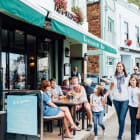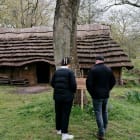
A walk around the leafy lanes surrounding La Hougue Bie, with a final stop at the Tearoom for tea and cake!
Walk Details
- 1 hour
- Starts at: La Hougue Bie
- Ends at: La Hougue Bie
- 2.2 Miles
- Beginner
La Hougue Bie is a Neolithic passage grave of international importance with a medieval chapel on top of the mound. The passage grave was discovered and excavated in 1924 and is in an excellent state of preservation. At 18 metres long, it is one of the largest passage graves in Western Europe.
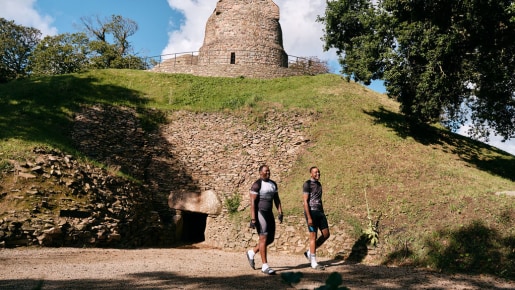
La Hougue Bie
Leave La Hougue Bie and turn left onto the main road. Continue straight on into La Rue des Pigneaux.
On the right you will pass La Maison de la Hougue Bie, a 19th century farmhouse full of historic character. The initials on the datestone above the front door stand for Isaac Aubin and Anne Filleul.
There are several more farmhouses along this road and on the right you may spot a small orchard. Small quantities of cider were traditionally made on Jersey farms but it became the Island’s major export in the 18th century when a quarter of the land was planted with orchards. The vast quantities of apples to be harvested and turned into cider were more than a family farm could manage and seasonal workers, usually French, were brought in to help. These workers were often paid part of their wages in cider!
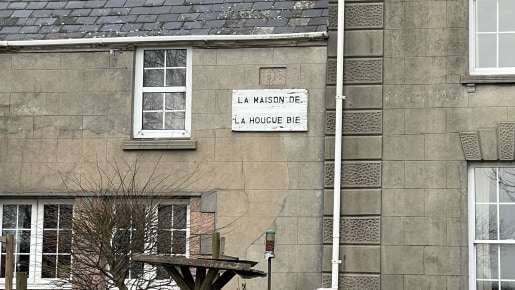
La Maison de la Hougue Bie
At the end of the road, turn right and continue as far as Eden Chapel.
Eden Chapel: On the right you will pass Eden Farm where the earliest building dates back to the 16th century. At the end of the road you will find Eden Chapel which was opened in September 1833 – note the datestone above the door. Methodism was introduced to Jersey in the 1770s and John Wesley, the founder of Methodism, visited the Island in 1787. There were chapels in all of the Island’s twelve parishes by 1838 and Methodism prospered among its independently-minded farming and fishing communities.
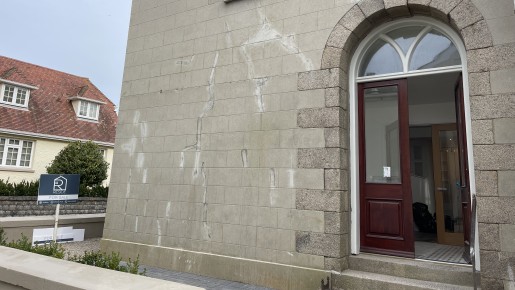
Eden Chapel
By the Chapel, turn left into La Rue des Friquettes.
On the right you will pass Eden House. This was almost certainly built in 1850 as it is not shown on the Godfray map of Jersey of 1849 but it does appear in the earliest census of 1851. The occupant is listed as William Handcock, a Wesleyan Minister.
Across the open fields to your right you can see La Ronde Porte, a group of farm buildings dating from the 18th century that remain remarkably intact, including the original granite apple crusher for cider-making and a bakehouse with bread oven.
Continue along La Rue des Friquettes and turn left into La Rue des Houguettes and walk past St Michael’s School.
St Michael’s School: The school occupies an imposing mid-19th century house that was built by the Durell family and originally known as La Houguette. In the 1870s, the house was owned by John Vaudin, the Constable of St Saviour. The property was used briefly as La Houguette Nursing Home in the late 1940s, and was purchased for use as St Michael’s School in 1952.
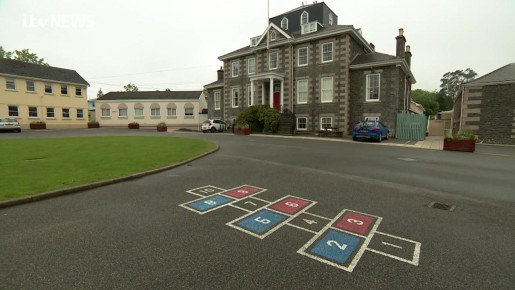
St Michael’s School
Continue to the end of this road.
Notice the old wooden gate in the attractive granite wall on your left.
At the main road, turn right and walk carefully along the pavement.
Look out for a small granite stone in the pavement that is inscribed with a number ‘2’. This marker stone indicates that we are two miles from the centre of St Helier.
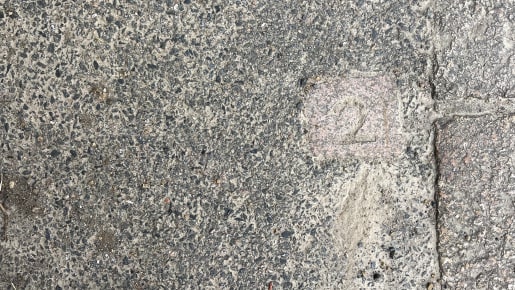
A mile marker
Ignore the first lane on the other side of the road and cross over carefully when you are opposite the second lane which is called La Rue du Pré.
At the start of this lane there is a granite lavoir, a communal washing-place for clothes that was built in the 19th century. A diverted stream enters through a projecting stone spout that empties into a stone trough and then flows along a granite gulley before exiting the lavoir on the far side. The lavoir was donated to the National Trust for Jersey in 1987 and is an important part of the Island’s roadside heritage.
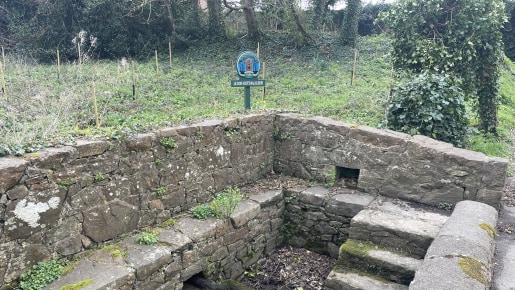
A Lavoir
Walk to the end of La Rue du Pré and turn right into La Rue du Tapon.
A little way along on the right you will find Highstead, a historic farmstead dating back to the 18th century. The main house is a good example of a Regency rural villa and has many original features such as mahogany doors and staircase and gold leaf decorative details.
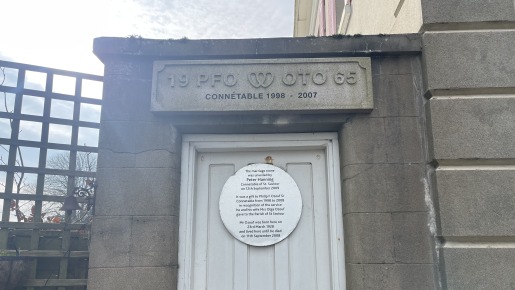
A marriage stone on the gate at Highstead
Continue walking until you reach a left turn into La Rue du Paradis.
Enjoy the wide open fields and far-reaching views to the sea.
At the end of the lane, turn left and then immediately right into La Petite Route du Nord.
The open fields in this area often have names such as ‘hougue’ (meaning ‘mound’) or ‘pouquelaye’ (meaning ‘dolmen’) and that can indicate a manmade mound or structure in or near to the field, although it may not now be apparent. These might be prehistoric in origin. Field names such as ‘Clos de la Blanche Pierre’ can also suggest the presence of a menhir or standing stone as ‘Blanche Pierre’ translates as ‘white stone’.
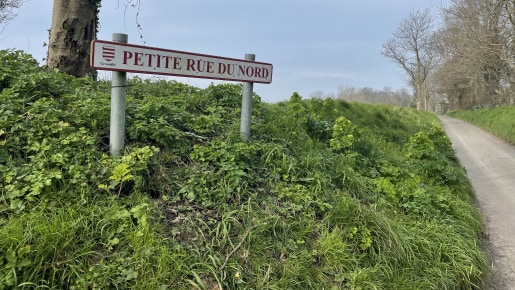
La Petite Route du Nord.
Turn left into La Rue du Francheville and walk to the end of the road.
On the left, you will pass Broadlands, a very grand Regency style property with many outbuildings.
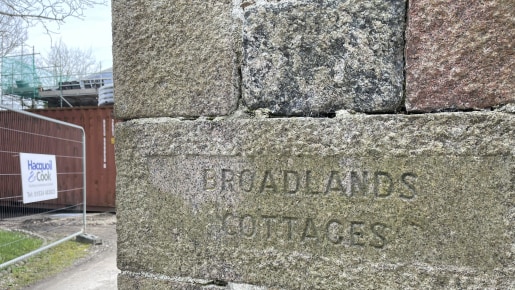
Broadlands Cottages
At the junction with the main road, walk carefully back towards the entrance to La Hougue Bie.
Before you enter the Tearoom, have a close look at the building – from top to bottom! It incorporates some original features of the 18th century Gothic tower that once stood on top of the medieval chapel on the mound. The tower was built by Philippe d’Auvergne and it was known as the Prince’s Tower. In the 1820s, the site was developed as a pleasure grounds, and a hotel and a bowling alley added to the attractions for Victorian visitors. The weather vane on top of the Tearoom building is the D’Auvergne coat of arms, the curved wooden door to the right of the Tearoom came from the round tower, and the black and white marble floor tiles in front of the floor were salvaged from the 18th century chapel built by D’Auvergne.
Enjoy some well earned refreshments in the Tearoom and explore La Hougue Bie with a free guided tour (entry fees apply for non-Members).

A weather vane with the D’Auvergne coat of arms
What's On
Searching for Jersey’s Celts
The world's largest Celtic hoard was discovered in Jersey, this exhibition explores why people might have buried it there.











